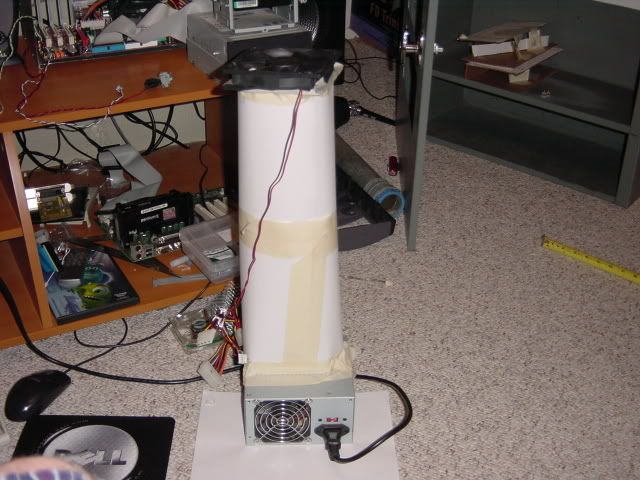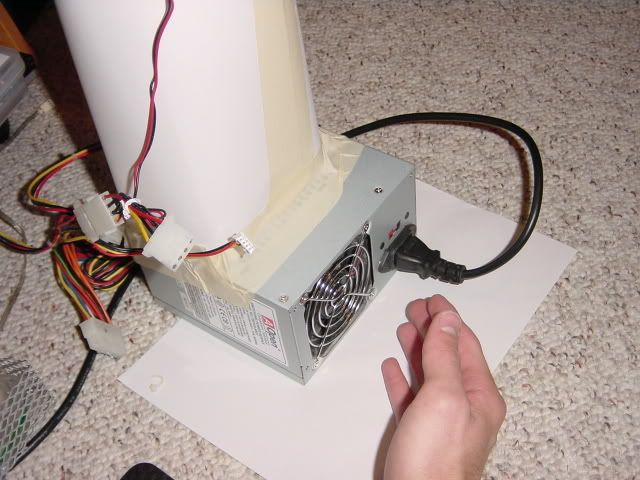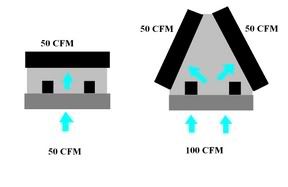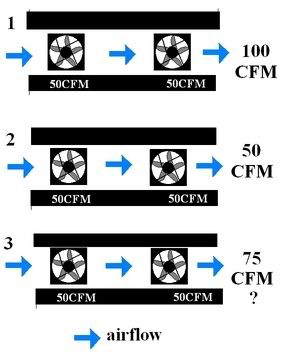Navigation
Install the app
How to install the app on iOS
Follow along with the video below to see how to install our site as a web app on your home screen.
Note: This feature may not be available in some browsers.
More options
You are using an out of date browser. It may not display this or other websites correctly.
You should upgrade or use an alternative browser.
You should upgrade or use an alternative browser.
CFM adding... How does it work?
- Thread starter Geo Fry
- Start date
Rabid Badger
2[H]4U
- Joined
- Mar 9, 2006
- Messages
- 2,093
Stacking is only beneficial if the pressure on the exhaust side is greater than on the intake side or if signifigant air flow resistance exists. Otherwise, you're just making more noise.
dtess17 said:are we talking in a case or stacked on a heatsink ?
i suppose in a case... Im trying to get into case modding and plan on doing lots of ducting. I just want to know how CFM works
Rabid Badger
2[H]4U
- Joined
- Mar 9, 2006
- Messages
- 2,093
In and ideal situation your intake and exhaust will be balanced, your computer won't be crammed in a confined area and your case will be organized to encourage free airflow, thus negating the need for stacked fans. If this doesn't describe your situation, rectifiying it would take about the same amount of time as stacking another fan on top of your exhaust or intake and would be a better solution.
ValeX said:If I was on an uber cheezy reality TV show, and this was the question for $10,000,000....I'd pick #3.....not like that helps though.
ValeX
LMAO nice way to put it
Yea thats what I was thinking... so in your honour (but mainly my boredom) i decided to do a test.
I ducted a 120mm Antec fan to a PSU exhaust... why I chose this setup? I have no clue
Anyways here is pic 1

The 120mm antec is off but the psu fan is on. air is minimal coming out of the psu... pretty much as a normal psu would have.
pic 2

Here both fans are on and the noise has definitely picked up a notch (but still very quiet). I know it doesnt look like the fans are moving but its just the fast exposure time on the camera.
I dont have any way to measure any difference in final air flow but:

I can definitely feel a difference
CONCLUSION:
even though this experiment was not exactly like the topic it does conclude that adding a higher CFM fan to a lower one will yeild higher total CFM... and since this is totally and completely obvious, the experiment was pointless
On another note: I guess I have no life
Geo Fry said:i suppose in a case... Im trying to get into case modding and plan on doing lots of ducting. I just want to know how CFM works...
While testing various configs to maximize cooling on my very large heat sink, I experimented with whaat you are asking.and concluded a few things:
1) the fan on the downstream-airflow side always experienced increased RPMs: like 4200 -> 4400.
2) Overall temp would drop, but never more than 1-2 degrees.
3) So as somone already offered, the 2nd fan serves only to help overcome resistance, but possibly not just on the exaust side? Less air-resistance on the intake side would seem to account for the increase in RPM, thus CFM. But I guess if air resistance is the only type around, then the net gain is so minor as to not be worth it...at least not when stacked directly on eachother...
4) because my radiator plates/fins are staced so closely, I assume this creates much more resistance, increasing over distance. With a single fan pushing air through fins at 4000 rpm, much of the air came out the sides, not making it to opposite side. This resulted in definate net-cooling loss.
5) covering 2 sides to form a tunnel helped force air to travel complete distance over fins, with maked improvement in cooling especially in reducing the max temps reached under CPU stress tests... (78C ->71C)
6) the addition of 2nd fan in series at opposite end of tunnel didn't do much for max (71C -> 69/70C), however it DID lower the coolest temp CPU sits at under minimal load ((58C -> 53/54C)
One other note: I also used 2nd fan reversed, blowing back toward 1st fan, and tried various amounts of RPM/CFM resistance like this. Oh, and I had unblocked the "sides" so no more tunnel...myy theory being that since increased turbulance over exchange plate in an H2O cooling system results in much better heat transfer, that inducing turbulace like this with an opposite fan would achieve same thing over fins. Unfortunately it didn't work out well...temps went up instead of down...and no idea why same principle didn't hold. Perhaps because turbulance in a water block = > time eack molecule is in contact with wall, but air molecules have such different thermal properties that its apples and oranges.
Or perhaps I should just stick to painting houses and building decks...
Q
Rabid Badger
2[H]4U
- Joined
- Mar 9, 2006
- Messages
- 2,093
To answer your initial question (which I just realized I didn't actually do):
The correct answer is 2, same CFM, higher pressure. This is why a second fan will help overcome resistance in the case of a radiator, but not lower temps in a well-balanced case.
The correct answer is 2, same CFM, higher pressure. This is why a second fan will help overcome resistance in the case of a radiator, but not lower temps in a well-balanced case.
QualiC said:One other note: I also used 2nd fan reversed, blowing back toward 1st fan, and tried various amounts of RPM/CFM resistance like this. Oh, and I had unblocked the "sides" so no more tunnel...myy theory being that since increased turbulance over exchange plate in an H2O cooling system results in much better heat transfer, that inducing turbulace like this with an opposite fan would achieve same thing over fins. Unfortunately it didn't work out well...temps went up instead of down...and no idea why same principle didn't hold. Perhaps because turbulance in a water block = > time eack molecule is in contact with wall, but air molecules have such different thermal properties that its apples and oranges.
Q
Definitely some good insight there... I guess heatsinks like fast slippery air and not slow turbulant air (same goes for radiators obviously)...
I think the obvious conclusion to this thread is that fans in series will only increase the pressure and thus may increase the fan rpm due to less resistance... but the increase will only be minimal and only have minimal CFM increase.
Since it is higher CFM that makes cooling more effective, than what is the purpose for the air pressure? Obviously in a water cooled system head pressure is needed to push the water through all the waterblocks; if there is too much water resistance than slap on another pump and bam! more head pressure.
But in an air cooled case, resistance comes from all objects... Another reason to keep those cases tidy and free of cables
OK so I've come up with a concept and want to see what you guys think...In a typical radiator situation, max performance is reached by using a 100 CFM fan before high diminishing returns. The only problem with these high speed fans is that they are so LOUD! So based on the info above why cant we just have 2 lower CFM fans pushing air through the same space... thus adding their CFM together....
For Example:...
A double 120mm radiator would have 4 fans IN PARALLEL (since in series will only increase preasure, not CFM)...
(all pics still done in paint )
)

If each fan was rated at 50 CFM... then each 120mm space would have a total of 100CFM for a grand total of 200CFM!!! using only quiet 50 CFM fans
How would you get these fans attatched to the radiator? By making a custom shroud of course


So... this way you could get higher airflow with slower, quieter fans... or just go crazy with it and have all 100 CFM fans!!!
Tell me what yall think and if you see any problems with this... as I am gunna be attempting it in my next case mod project
For Example:...
A double 120mm radiator would have 4 fans IN PARALLEL (since in series will only increase preasure, not CFM)...
(all pics still done in paint

If each fan was rated at 50 CFM... then each 120mm space would have a total of 100CFM for a grand total of 200CFM!!! using only quiet 50 CFM fans
How would you get these fans attatched to the radiator? By making a custom shroud of course

So... this way you could get higher airflow with slower, quieter fans... or just go crazy with it and have all 100 CFM fans!!!
Tell me what yall think and if you see any problems with this... as I am gunna be attempting it in my next case mod project
nst6563 said:Are you going to have the fans suck or blow? If they're sucking the air through the rad, I would think that there would be enough resistance that the fans would start working against each other.
and again...nice "paint" job
lol thanks...
i am going to have them suck the air through the radiator, and yes i have thought about the fact that they will be working against each other... but something to note is that the picture i drew is not AT ALL to scale. the fans wont be nearly as vertical, actually almost to a right angle.
i know this because I did a mock up of it (like i did with the PSU) using some cardboard that i cutout and 2 antec 120mm fans... i pretty much made a cardboard shroud based around the dimensions of a double rad (should of taken pictures of it). It actually works pretty good... with both fans sucking the air has no where to go except from the bottom where the rad would be.
I tested the difference with only one fan running and then both and the difference is quite significant... and the best part is it creates a very small increase in noise!
A problem i forsee is when you get the resistance from the radiator... I mean you'll still have more CFM using 2 fans over one but you probably wont get 50CFM + 50CFM = 100CFM. It'll be more like 50CFM + 50CFM = 75CFM . After all the back pressure and slightly slower rpms are taken into play.
Does anyone understand what I am saying??!? Or am i just rambling to myself... I mean this is the cooling forum section
Here's the basic rules to make it all clean and simple.
A fan will never push it's rated cfm in an installed situation. That only happens in the manufactuers free space test conditions.
A fan setup where a path of air is created and travels in series, will increase the cfm only a little, but never above the manufacturers rated cfm. The increase in pressure just translates into an increase in cfms.
A fan setup where there is no path of air in series, but in parallel, and the fans are installed in parallel can result in a net increase of cfm that is greater than a single fan. This increased cfm can be double that of a single fan, but usually is slightly less. However, if there is a lot of resistance then you might only net a small increase in cfm.
In your radiator case, Having 4 fans in parallel will blow more air than 2 fans in parallel, but you'll see diminishing returns. Slower and quieter fans not only blow less air, they also don't cope with air flow resistance as well either.
Basically, your working with air volume and air pressure. To blow a given volume of air through an object, you will need a certain amount of air pressure. If you don't have enough pressure, then less air will be blown through.
A fan will never push it's rated cfm in an installed situation. That only happens in the manufactuers free space test conditions.
A fan setup where a path of air is created and travels in series, will increase the cfm only a little, but never above the manufacturers rated cfm. The increase in pressure just translates into an increase in cfms.
A fan setup where there is no path of air in series, but in parallel, and the fans are installed in parallel can result in a net increase of cfm that is greater than a single fan. This increased cfm can be double that of a single fan, but usually is slightly less. However, if there is a lot of resistance then you might only net a small increase in cfm.
In your radiator case, Having 4 fans in parallel will blow more air than 2 fans in parallel, but you'll see diminishing returns. Slower and quieter fans not only blow less air, they also don't cope with air flow resistance as well either.
Basically, your working with air volume and air pressure. To blow a given volume of air through an object, you will need a certain amount of air pressure. If you don't have enough pressure, then less air will be blown through.
I tried a few fan combinations in straight series air flow, monitoring only temperatures with MBM5, using Panaflo M1A 120mm fans, both fans at 7V.
With the matched Panaflos at front intake intake and and rear exhaust, temps were slightly lower - 1C to 2C lower - than with a single Panaflo at either front or rear. I'm running the matched Panaflos now.
What really surprised me was a trial configuration with mis-matched fans in series combination, using Panaflo M1A 120mm at 7V in series-flow with a 'silent' low-flow Nexus fan at 12V:
- Temps with Panaflo at rear and Nexus at front intake were the same as with the Nexus alone at either exhaust or intake. No 'help' from the Panaflo at all, the low-flow fan was a hard flow-restrictor.
Conclusion for series fan configurations:
- Matched-flow fans do provide a small total flow improvement.
- For mismatched series fans, flow will be limited to the flow-rate of the slower fan.
With the matched Panaflos at front intake intake and and rear exhaust, temps were slightly lower - 1C to 2C lower - than with a single Panaflo at either front or rear. I'm running the matched Panaflos now.
What really surprised me was a trial configuration with mis-matched fans in series combination, using Panaflo M1A 120mm at 7V in series-flow with a 'silent' low-flow Nexus fan at 12V:
- Temps with Panaflo at rear and Nexus at front intake were the same as with the Nexus alone at either exhaust or intake. No 'help' from the Panaflo at all, the low-flow fan was a hard flow-restrictor.
Conclusion for series fan configurations:
- Matched-flow fans do provide a small total flow improvement.
- For mismatched series fans, flow will be limited to the flow-rate of the slower fan.
gud4u said:Conclusion for series fan configurations:
- Matched-flow fans do provide a small total flow improvement.
- For mismatched series fans, flow will be limited to the flow-rate of the slower fan.
Cool thanks... that makes plenty of sense
And Rix2357 , as for what you said I cannot argue with you at all. Low power fans not only push less CFM but have less resistance to... well... resistance.
What I was looking for in the drawings was a way to get relatively high CFM pulled through a radiator without using loud high CFM fans... although using double the amount of fans while semi-going against each other could make just as much noise. I'm not sure.
BUT... I intend to find out
Today this came from FedEX

2 of the new Black Ice GT radiators!! yaya
One I will be setting up in typical pull fashion and the other I will be making a custom shroud to get 4 pulling through it... this will take some time so dont expect anything soon. (Now I just need a total of 6 matched 120mm fans
I love how people keep experimenting with their fan setups... KEEP IT COMING and tell me what ya find!
![[H]ard|Forum](/styles/hardforum/xenforo/logo_dark.png)
